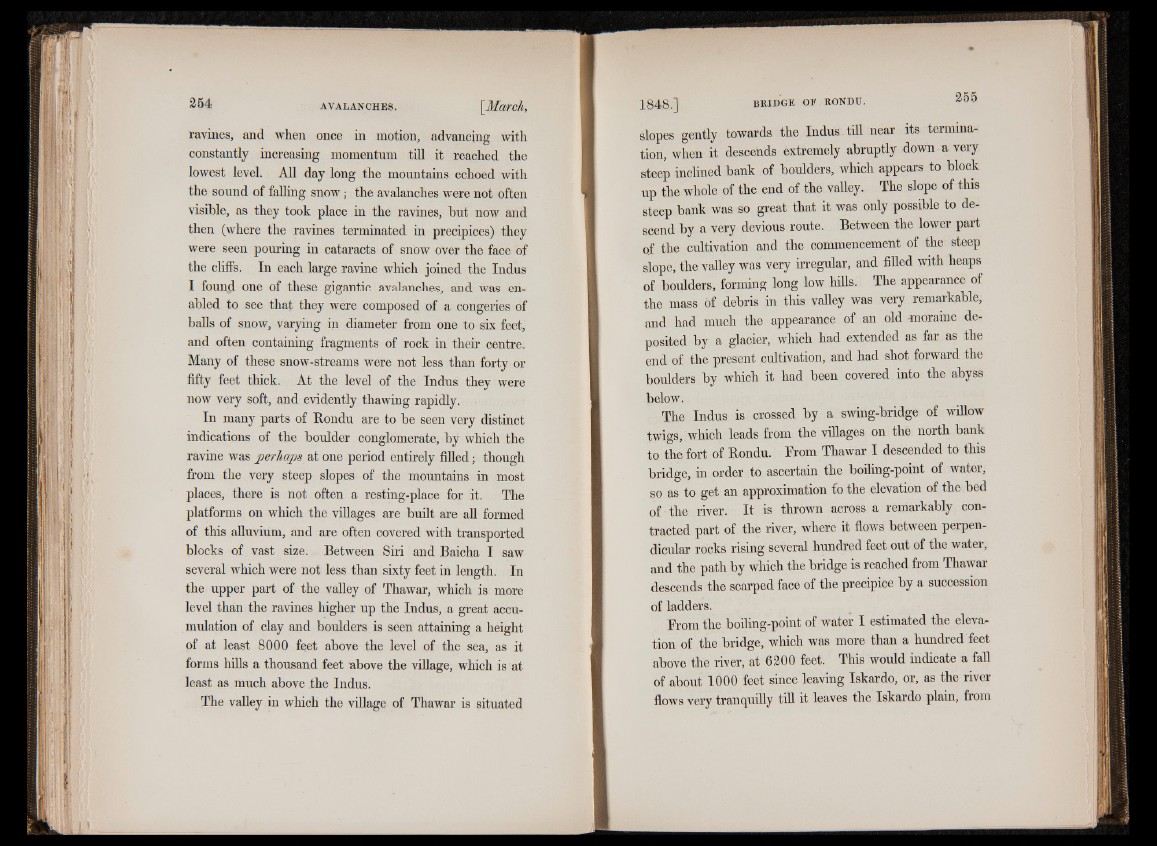
ravines, and when once in motion, advancing with
constantly increasing momentum till it reached the
lowest level. All day long the mountains echoed with
the sound of falling snow; the avalanches were not often
visible, as they took place in the ravines, but now and
then (where the ravines terminated in precipices) they
were seen pouring in cataracts of snow over the face of
the cliffs. In each large ravine which joined the Indus
I found one of these gigantic avalanches, and was enabled
to see that they were composed of a congeries of
balls of snow, varying in diameter from one to six feet,
and often containing fragments of rock in their centre.
Many of these snow-streams were not less than forty or
fifty feet thick. At the level of the Indus they were
now very soft, and evidently thawing rapidly.
In many parts of Rondu are to be seen very distinct
indications of the boulder conglomerate, by which the
ravine was perhaps at one period entirely filled; though
from the very steep slopes of the mountains in most
places, there is not often a resting-place for it. The
platforms on which the villages are built are all formed
of this alluvium, and are often covered with transported
blocks of vast size. Between Siri and Baicha I saw
several which were not less than sixty feet in length. In
the upper part of the valley of Thawar, which is more
level than the ravines higher up the Indus, a great accumulation
of clay and boulders is seen attaining a height
of at least 8000 feet above the level of the sea, as it
forms hills a thousand feet above the village, which is at
least as much above the Indus.
The valley in which the village of Thawar is situated
slopes gently towards the Indus till near its termination,
when it descends extremely abruptly down a very
steep inclined bank of boulders, which appears to block
up the whole of the end of the valley. The slope of this
steep bank was so great that it was only possible to descend
by a very devious route. Between the lower part
of the cultivation and the commencement of the steep
slope, the valley was very irregular, and filled with heaps
of boulders, forming long low hills. The appearance of
the mass of debris in this valley was very remarkable,
and had much the appearance of an old ■moraine deposited
by a glacier, which had extended as far as the
end of the present cultivation, and had shot forward the
boulders by which it had been covered into the abyss
below.
The Indus is crossed by a swing-bridge of willow
twigs, which leads from the villages on the north bank
to the fort of Rondu. From Thawar I descended to this
bridge, in order to ascertain the boiling-point of water,
so as to get an approximation fo the elevation of the bed
of the river. It is thrown across a remarkably contracted
part of the river, where it flows between perpendicular
rocks rising several hundred feet out of the water,
and the path by which the bridge is reached from Thawar
descends the scarped face of the precipice by a succession
of ladders.
From the boiling-point of water I estimated the elevation
of the bridge, which was more than a hundred feet
above the river, at 6200 feet. This would indicate a fall
of about 1000 feet since leaving Iskardo, or, as the river
flows very tranquilly till it leaves the Iskardo plain, from